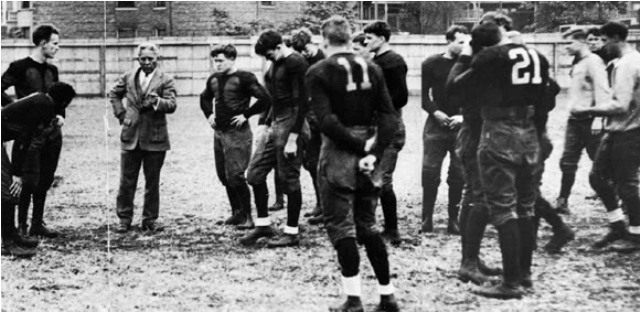89 Years Ago Today, College Football Entered the Radio Age
By Chuck Sudo in News on Oct 28, 2011 6:50PM

Chicago Maroons coach Amos Alonzo Stagg (in suit) with his players.
For many football fans the Saturday slate of college football games is only slightly less reverent to the Sunday NFL schedule. Graduates of all ages don the jerseys and colors of their alma maters to cheer on the young men who take to the gridiron every weekend.
College football is a big business and, on this date in 1922, the first cross-country radio broadcast of a college football happened as Princeton's "Team of Destiny," led by Herb Treat and Pink Baker, visited the University of Chicago to take on legendary coach Amos Alonso Stagg and his Chicago Maroons.
The game was broadcast from Stagg Field from KYW, a Westinghouse radio station based in Chicago via telephone lines to WEAF, an American Telephone & Telegraph station in New York City. Princeton's football timeline also indicates this was the first game to be broadcast on WOR radio.
Stagg's teams were the powerhouse of the time and Stagg himself is credited with many of the innovations seen in the modern football game, including the onside kick; center snap; T formation; lateral pass; quarterback sneak; varsity letters on jerseys; the forward pass; the man in motion; and the Statue of Liberty play. It's also often forgotten that the University of Chicago was a founding member of the Big Ten Conference and Stagg's Maroons were perennial contenders for the Big ten title, winning it seven times in Stagg's 40-year career at U of C.
His Maroons jumped to an early 18-7 lead over the Tigers. But Princeton rallied in the fourth quarter thanks to some stalwart defense. Princeton foiled Chicago four times near the goal line to pull off a 21-18 win, go undefeated and claim a national championship.
The History Channel writes of the radio broadcast:
[Princeton fans] thronged the town’s main street, lit bonfires and stole into Nassau Hall to ring the University’s bell, a celebration usually reserved for victories over Princeton’s Big Three rivals Harvard and Yale.
The New York Times wrote of Princeton fans "cheering madly one minute, groaning hoarsely the next." Not a bad reaction for a game that was the 1920s version of tape delay. But then, radio lent itself well to athletic event; they were among the first things radio stations could air and guarantee advertisers and sponsors an audience.
It would be another two years before the first live broadcast of a college football game, but that fateful day in Chicago surely set the stage.